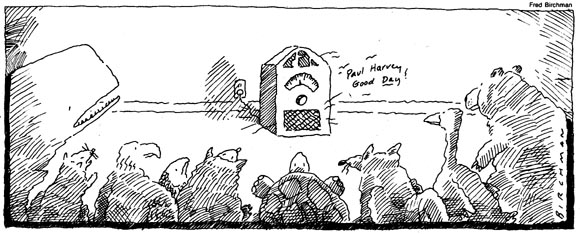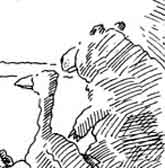Wildlife
Tracking By Transmitter
by Bruce Brown

Original drawing by Fred Birchman for the Seattle Weekly.
IT'S 11 O'CLOCK at night. Do you know where your wombat is? There is a way to find out. In fact, it is now possible to electronically determine the whereabouts of many wild animals through telemetry, the science of transmitting information over long distances via radio signals.
Capable of relaying data on a variety of activities (such as whether a bird is in flight) as well as location, battery-powered VHF radio transmitters have been designed to function in every element, and have been fitted to an amazing array of wild creatures, including whales, bears, eagles, seals, gila monsters, sea turtles, caribou, geese, kangaroos, salmon, and bats.
The purpose of wildlife telemetry is to observe aspects of animals which are, under normal circumstances and with conventional senses, hidden. "If you can observe the animals directly, I wouldn't mess around with telemetry," said Stanley Tomkiewicz, biotelemetry system engineer for Telonics, an Arizona firm that has manufactured many of the 1,000 telemetric devices estimated to be in operation in Washington today. "But the thing is," Tomkiewicz added, "a lot of wild animals are hard to observe."
Telonics got its start 20 years ago when Tomkiewicz's boss, David Beaty, was asked if it was possible to make a radio transmitter that could be attached to Abert squirrels in Arizona. At the time, Beaty (who worked for Motorola on aerospace telemetry projects) thought it might be possible to make transmitters small enough for a deer, but squirrels were out of the question. Since then the incredible miniaturization of electronics has made transmitters possible not just for squirrels, but bats. According to Eric Dinerstein, bats in Costa Rica have recently been fitted with transmitters weighing as little as 5 grams, including batteries and all the other gear.
Tomkiewicz, who was in Seattle last month with Beaty to deliver a Wildlife Telemetry Workshop sponsored by the National Park Service and the Woodland Park Zoo, said that telemetry packs so small they can be fitted to hummingbirds may be a possibility within the next two or three years. The other big development on the horizon in wildlife telemetry and surveillance is direct satellite hook-up. At present; wild animals equipped with radios must be tracked manually, generally by plane or car. The National Oceanographic and Atmospheric Administration is presently in the process of putting up two polar orbiters that will make satellite tracking of animals possible.
Wildlife telemetry has already been used to gain intimate knowledge about various creatures (such as whether a doe has fawned), but most experienced biologists and wildlife managers at the Seattle conference agreed that what telemetry does best is track the simple movement of hard-to-find animals. A recent example is a gray whale that was tagged in Mexico's San Ignacio Lagoon, and showed up 91 days later in the Aleutian Islands. The range of the transmit depends on many factors, including medium and exposure (because saltwater does not transmit VHF signals, whale telemetry packs must be placed to come out of the water when the leviathan blows). By the same token, radio transmitters that have been surgically implanted in animals (as is frequently done with otter) do not have as great a range as those that are externally, fitted. On the lower end of the scale, a small, relatively weak transmitter might have a range of three miles, while a larger device on a high soaring raptor might be tracked for 100 miles or more.
A typical wildlife-telemetry setup includes a power source (generally lithium batteries, sometimes with solar-assist), a transmitting antenna (loop, helical coil, or whip), actual transmitter (often a simple one, although more complex types are also use) and an impervious package to contain the electronics and attach them to the animal (collar, harness, or surgical implant). The person on the other end receives the signal with a "Yagi" antenna (the classic TV antenna with an array of parallel elements), and an actual receiver (which is often hooked up to both headphones and a data recorder). Flying is often the best way to follow the signal of a radio-equipped animal on the ground, but for radio-equipped birds the reverse is true. Bud Anderson, a Kirkland raptor biologist, has equipped his car for this purpose by installing a ball-bearing socket on the floor between the front seats and cutting a hole in the plexiglass sunroof immediately above, through which he inserts a rotating Yagi antenna that gives the impression he's got a console color TV stashed in his small Dodge.
Anderson is not watching the soaps as he cruises the back roads of Whatcom County, however. He is following a peregrine falcon he has outfitted with a transmitter, although a fair amount of the time he picks up Canadian taxi cabs and other miscellaneous communications. Beaty and Tomkiewicz also stressed that telemetry may yield unexpected or difficult to explain results. After 10 hours of often quite technical discussion of microelectronics, Beaty smiled and said, "Now we come to the black magic." As an example, Beaty described the time people tracking a radio-equipped deer in an Arizona thicket got within 50 yards of the animal, at which point the deer vanished telemetrically, only to reappear ear a few minutes later, and vanish again whenever approached within that range. Later it was discovered that the phenomenon was related to the directional loop antenna on the deer, which only works when viewed "on end," and becomes a radio void when viewed "head on" as an "O." Since the antenna was sewn around the deer's collar, as soon as the man with the antenna got close enough to be heard or smelled, the deer would turn its head in that direction, presenting the broad part of the loop, and disappearing. According to Beaty, this particular problem was solved by going to short-whip antennas.
Among other telemetric mysteries Beaty and Tomkiewicz mentioned: a mountain lion that seemed to have traveled an amazing distance of 200 miles overnight (it turned out that a university research group in a neighboring state had started broadcasting on the same wavelength), the discovery of a hitherto unreported 30-day cycle in the body temperature of opossums (it turned out that the biologist was changing the batteries every 30 days), and the arrest of two fishermen for poaching a radio-tagged fish (it turned out the signal the game wardens were picking up was coming from a radio-tagged eagle on the cliff behind). In addition to the natural doubling and cancellation of radio waves that occurs as they bounce off cliffs and other natural objects, there are other forces at play. Tomkiewicz described biologists who were studying a quail that had been -- unbeknown to them -- eaten by a coyote. "They tracked the coyote for a while before they figured it out," he said. "I guess you might call that following your studies up the food chain."
The most difficult technical challenge of wildlife telemetry is probably not electronic at all. though. It is packaging the electronic and attaching them to the animal. Among Beaty's displays was an impressive collection of trashed transmitters. One collar, which had been attached (briefly) to a mountain lion, had been flayed like Herculite chiffon. Another transmitter, which had been bone-screwed to the shell of a turtle, resembled a cheap watch that had been hit with a hammer. For some of these animals, the struggle against the collar is a struggle against death. Beaty noted that howler monkeys were originally equipped with telemetry packs inside leather collars. The animals tried desperately to get them off, and many that did not succeed died. The reason for the "significant mortality" was that howlers groom each other to control lethal parasites. The collars interfered with this and therefore spelled their doom.
The image of howler monkeys sitting face-to-face, their feet braced against each other's chests, tugging at each other's collars until they gave up is a truly sad one, and illustrates the fact that the collar is more than a metaphor for the loss of freedom. It is a physical fact with serious implications for wild animals, weighing real risks against real gains. Beaty and Tomkiewicz clearly have a deep concern for the well-being of the animals. They want researchers to be realistic about the limitation of telemetry, but other factors (such as a never-ending appetite for new and improved gadgetry) apply pressure in the opposite direction. And either way, recent advances in aerospace, military, and medical technology seem certain to propel wildlife telemetry to greater levels of sophistication and wider application.
Telemetry may see some not-so-wildlife applications too. Tomkiewicz said, "We get a lot of calls from people who want to put transmitters on their cat or their husband. Were not into that at all, and we don't want to deal with those people. " One suspects that someone else may be willing to deal with them, though, raising some alarming possibilities.
How long will it be until Liz Taylor has her little dogs equipped for direct satellite hook-up?
"Wildlife Tracking By Transmitter" originally appeared in the May 9, 1984 issue of the Seattle Weekly.
© Copyright 1984 Bruce Brown
© Copyright 1973 - 2020 by Bruce Brown and BF Communications Inc.
and BF Communications Inc.
Astonisher and Astonisher.com
are trademarks of BF Communications Inc.
BF Communications Inc.
P.O. Box 393
Sumas, WA 98295 USA
(360) 927-3234
Website by Running Dog 
|
|





|




![]()









